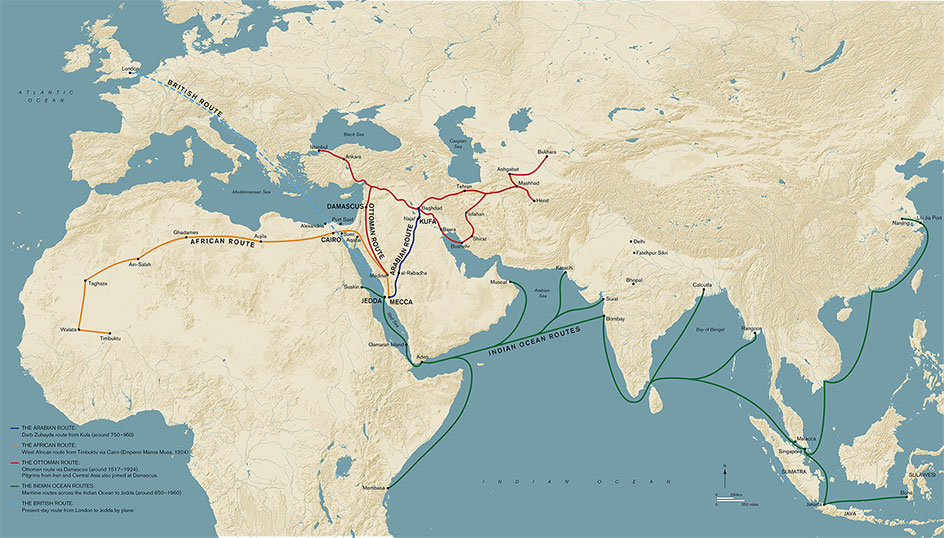many years the Ottoman Turks had in dealing with
contagious diseases and the related quarantines and
other measures required for pilgrims coming to Mecca
from around the Moslem world.//

Map showing pilgrimage routes.
Second Section
Even if their passengers are free from cholera, plague and yellow fever,
ships coming from ports near to, or in contact with, countries where
the arforementioned diseases are prevalent are considered suspect ships.
Ships arriving from Sibu Island in Malaysia, Ceylon (Sri Lanka) and the
Dutch colonies in India, which are free of "İstranis setelmantis"
(evidently meaning a viral disease), but which carry more pilgrims, crew
and passengers than their manifests declare, are considered suspect ships.
All of the pilgrim ships with suspect pilgrims and passengers are subject
to five days quarantine and they and their clothes and belongings will be
taken to the quarantine station for fumigation and the ship itself will be
disinfected.
Nonetheless, if during the time in quarantine or while in transit to Jiddah
there are any incidents of cholera, plague and yellow fever among the
pilgrims, passengers and crew, special measures will be taken regarding
the contaminated ship and it will return to Kameran Island.
Third Section
Ships carrying passengers with cholera, plague and yellow fever on
which there were incidents of these diseases prior to departure or
during the voyage are considered contaminated ships.
Ships coming from ports in India and Sind (today's coastal Pakistan)
are considered contaminated ships, even if there were no incidents of
cholera, plague and yellow fever among those on board either prior to
or during the voyage, just like ships coming from other ports where
these diseases are known to exist.

Kameran Island is just above 'Hudeyde' (Hodeidah) near the
southern mouth of the Red Sea. The distance from Hodeidah
to Jiddah is 539 nautical miles.
These ships and the pilgrims and passengers they carry will be subject
to ten days quarantine and their clothes and belongings fumigated at
the quarantine station. If either at the time of departure, during the
voyage, upon arrival or in quarantine there were any incidents of
cholera, plague and yellow fever among those on board then the
afflicted persons will be transported from the ship to the hospital at
the Kameran quarantine station. The remaining passengers will also
be taken to the quarantine station and screened for the diseases. Those
with symptoms will be separated from the others, who will be allowed
to proceed.
The pilgrims and passengers suspected of being symptomatic will have
no contact with the ship they came on during their period in quarantine.
Their dirty clothes and belongings, as well as the crew's, will be
fumigated. The drinking water in the ship's hold will be replaced with
distilled water
From the date the ship and its pilgrims and passengers are identified
with cholera, plague and yellow fever they will be placed separately in
15 days of quarantine. Those who are free from those diseases will be
separated from those afflicted but will also be put into 15 days of
quarantine. For every two new incidents that occur, the quarantine will
be extended. Those who are suffering from the diseases will remain in
quaratine for 15 days after their recovery is confirmed.
Subsequently, if after the ship leaves Kameran Island and during the
voyage to Jiddah there are any new incidents of cholera, plague and
yellow fever then the ship will return to Kameran and be subjected to
the special measure described above for contaminated ships.
//END of PART II//

Hiç yorum yok:
Yorum Gönder